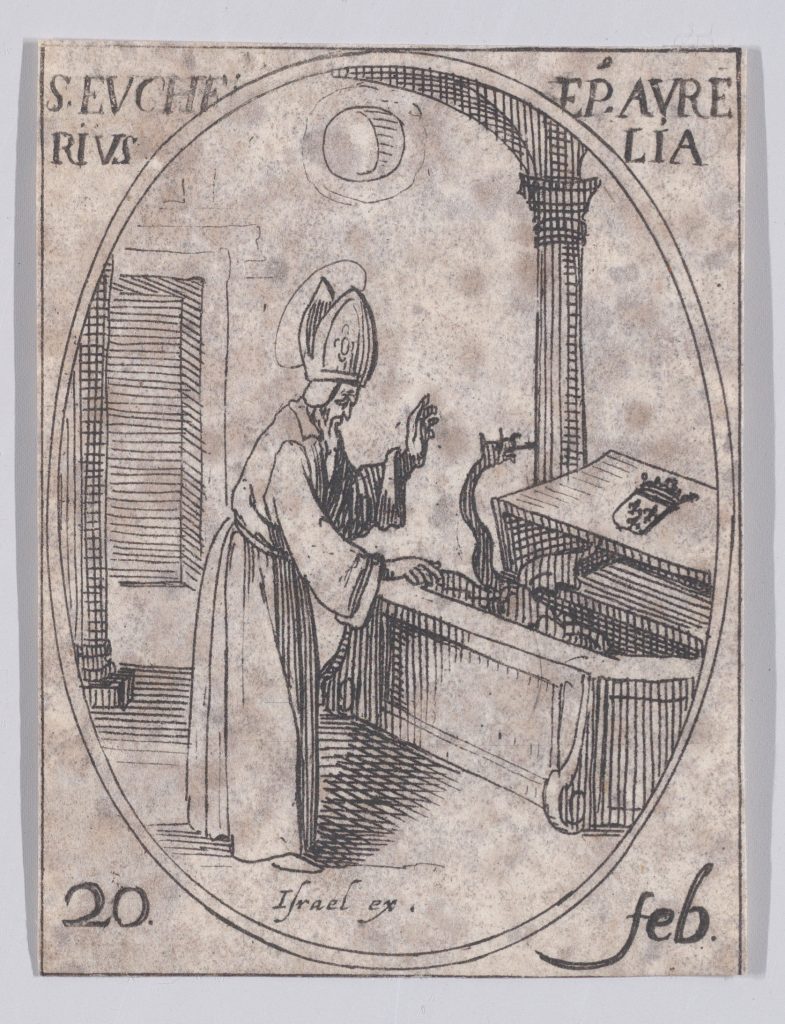Hincmar of Reims against Charles Martel
Barrie Brill
Letter from the Synod of Quierzy to Louis the German, 858
Hincmar of Reims reported to the Council of Quierzy, in 858, the vision that Bishop Eucherius of Orléans had seen during the reign of King Pippin III (the Short) over a century before. Eucherius was likely a nephew of Savaric [see Document 2], and of noble background. Establishing control over Francia meant reducing the independence of such lords. After his victory over the Muslims in 732, Charles was consolidating his hold on Burgundy and Eucherius had opposed him. Charles drove out Eucherius and his kinsmen and seized their lands to distribute to his own followers. This was not really a case of “secularisation”, but rather the confiscation of the resources of a great family whose wealth was based on an episcopal lordship. The memory of his treatment, which was preserved in his Life, was one of the reasons why the bishop was later venerated as a saint, and as his reputation grew, so did that of Charles Martel as a despoiler of Church lands. Eucherius was exiled to Cologne and retired to the Abbey of Saint Trond, where he spent his last years in prayer and contemplation until his death in 743. Hincmar used this vision of Eucherius a century later to support his arguments for the restoration of Church properties that had been seized over the centuries.
It was prince Charles[1], father of King Pippin[2], who was the first among all the kings and princes of the Franks to wrest and separate the goods of the churches from the churches: for this reason alone he was eternally damned. That was revealed by obvious signs. For the holy bishop Eucherius[3] of Orléans, who rests in the monastery of Saint Trond, while kneeling in prayer was seized and taken to another world, and amongst other things that the Lord showed him, he saw Charles being tortured in the bottom of hell. When Eucherius questioned the angel who was leading him about, the angel replied that by the judgement of the saints, who will judge in the future judgement with the Lord, and whose property he took and divided up: before that judgement, he [Charles] was condemned in body and soul to eternal punishment, and he had received these punishments both for his own sins but also for the sins of all those who, for the purpose of redeeming their souls, had given their goods and properties in the honour and love of the Lord to the places of the saints for the lighting of the divine worship and for the sustenance of the servants of Christ and the poor.

When Eucherius returned to himself, he called upon the holy Boniface[4] and Fulrad, Abbot of the monastery of Saint-Denis and the arch-chaplain of King Pippin[5]; he explained what he had seen to them, and gave as proof that they should go to Charles’s tomb, and if they could not find his body there, they must believe in the truth of his words. Therefore, they went to the aforementioned monastery where Charles’s body was buried; they opened his tomb and suddenly a dragon emerged, and the whole interior of the tomb was found to be blackened, as if it had been burned. We ourselves knew those who survived down to our time and who were present at this event and they testified to us verbally the truth of what they had heard and seen.
Questions for Consideration
- Why did the Church oppose the actions of Charles Martel even as Martel was backing the expansion of Christendom via Anglo-Saxon missionaries?
- Click to enlarge the image above. In what way does the artist reflect the concerns of the 17th Century?
Media Attributions
- The Vision of St Eucherius © Jacques Callot is licensed under a Public Domain license
- This refers to Charles Martel (d. 741) ↵
- Pippin III the Short (d. 768) ↵
- Eucherius of Orléans (687-738). Vita Eucherii Episcopi Aureliansis, ed. W. Levison, MGH, Scriptores Rerum Merovinicarum, vol. VII, [Hannover, 1920], 46-53. ↵
- This refers to Boniface, the Anglo-Saxon missionary to the Germanic lands ↵
- Fulrad, abbot of St. Denis and arch-chaplain and advisor to both Pippin III and Charlemagne. ↵

